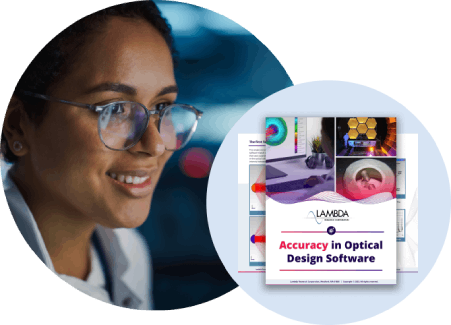OSLO Tolerancing
OSLO helps users balance cost and performance with its state-of -the art tolerancing tools. With OSLO you can control the impact manufacturing errors and control them cost-effectively with tolerances.
Surface Tolerances describe the quality of each surface:
- Radius of curvature
- Conic Constant
- Surface form error
- Irregularity surface form
- Thickness
- Axial Surface Shift
- Refractive index
- X, Y and Z surface tilt
- X and Y surface decenter
- Default tolerances according to ISO 10110
- X and Y decentration
- X and Y tilt about free aperture
- X and Y tilt about center of curvature
- User defined groups
- Group axial shift
- Group decenter
- Group tilt (x, y and z) about an arbitrary point
User-defined tolerancing Allows you to specify an error function to characterize system performance. This method provides the greatest flexibility for tolerancing, but has the slowest performance. Since this method is based on an error function, you can select which terms to display, so that only relevant data is shown.
Change table tolerancing This tool tells you how specific performance aspects of your system (see list below) will be affected by errors that you bound with tolerances. It has the advantage of not requiring an error function to be defined, and is great for comparing perturbed system performance for different optical systems.
MTF/Wavefront tolerancing This method uses the Hopkins-Tiziani algorithm, which allows you to tolerance a system based on an MTF or RMS wavefront evaluation. Although defining an error function and using User-defined tolerancing can also achieve this goal, MTF/Wavefront tolerancing may be as much as 100 times faster. Features include:
- Direct or inverse sensitivity
- Perturbation coefficients or direct output
- Tolerancing over all field points
- Tolerancing over all configurations
- Compensators over all configurations
- Simultaneous T&S tolerancing
- Statistical performance estimate
- User defined error function
- Statistics available for individual operands
- Specify number of systems to evaluate
- Select default, end-point, RSS, or Gaussian distributions
- Save generated systems
Compact Custom Output
OSLO includes features that simplify the interpretation of tolerance data:
A grade table (A, B, C, D), establishes ranges for which a tolerance is considered Very Tight (A), Tight (B), Standard (C), or Loose (D).
A display threshold can be used to suppress unimportant output.
Sorting routines allow you to find out at a glance which tolerances are critical.
Tolerancing Analysis and Design
OSLO allows you to chose from different tolerancing methods. Each method can be used for either analysis ("sensitivity") or design ("inverse sensitivity"), with the exception of Monte-Carlo (sensitivity only):- Best focus, back focus, focal length
- Magnification
- Transverse spherical
- Distortion, transverse distortion, shear
- Axial and field Conrady D-d
- Meridional and central coma
- Axial and field sags
- Axial and field RMS OPD
- Direct or equal RSS contribution

